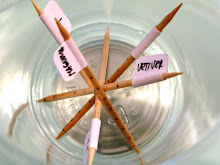You may compare Weekend Perfumer Sniffing Technique to a studying of red wine in a glass. Instead of traditional perfumer blotters this method relies on regular toothpicks and cheap plastic glasses.
The main principle of this sniffing practice is based on the fact that 5 cm (2 inches) of a toothpick absorbs 1 drop of essential oil or aromatic compound.
In other words when you dip a toothpick into a container with oil some of that oil will remain on the toothpick. And on average the amount of residue oil on 5 cm of a toothpick equals to a single drop of that oil.
Well, certainly different oils have different viscosity (not to mention resinoids which should be first diluted at least 50% in perfume alcohol) and are differently absorbed by toothpicks (takes anywhere from 4.3 cm to almost 6 cm to absorb a single drop). Perfume alcohol is an exception with just 3.6 cm per drop. Majority of essential oils and aromatic compounds come very close to 5 cm per drop.
Multiple sources suggest that perfume sampling should be done in concentrations of 10% or less. In our case 5 mm (1/4 inch) dip of a toothpick into oil will produce the same amount as a single drop of a 10% dilution. For a weekend perfumer this is an important time saver since now we don’t have to dilute all our oils prior to sampling. Obviously, oils with strong scent (ex. oak moss, labdanum, etc.) require substantial dilution for optimal sampling (10%, 1% or even 0.1%).
The easiest way to manage and test oils on toothpicks is to place them into a plastic glass and then sniff the scent.
Aerial mixing of different oils in a plastic glass is very efficient. Mixing liquids takes substantial time (often several days) while molecules mix very fast once airborne. So, instead of mixing oils, simply put toothpicks dipped into different oils into the same glass and sniff the combined aroma. Important: Aerial mixing works better in a larger glass.
Now we can mix different oils with amazing precision, quickly add or withdraw different ingredients, change their quantities and evaluate results immediately. No mess, no multitudes of bottles with different dilutions of the same material and all samples are easily contained in covered glasses.
Here are some how-to suggestions for preparing Marked Toothpicks for Weekend Perfumer Sniffing Technique.
1. Master Toothpicks
Master Toothpicks will be used to make all Marked Toothpicks, so please create them with patience and attention.
First, use a ruler to place 8 marks 5 mm (1/4”) apart (total marked length of 4 cm 1 ½”) on a toothpick.
Then circle marks all the way around toothpick, so that they will be clearly visible from all sides.
Finally, paint the top tip in solid black color (it will make it easy to find Maters among other toothpicks).
2. Multiplying Marked Toothpicks
Align unmarked toothpicks using a ruler and place Master Toothpicks on both sides of the row.
Apply little pressure when drawing a line across the row of toothpicks.
3. Labeling Marked Toothpicks
As you have heard probably a thousand times, perfume making is all about keeping records. Place ½ by ¾ inch self-adhesive labels around Marked Toothpicks to allow enough space for easy identification of toothpicks in a glass during experiments.
And now you are fully equipped to start your perfume explorations!
November 30, 2009
Subscribe to:
Post Comments (Atom)









No comments:
Post a Comment